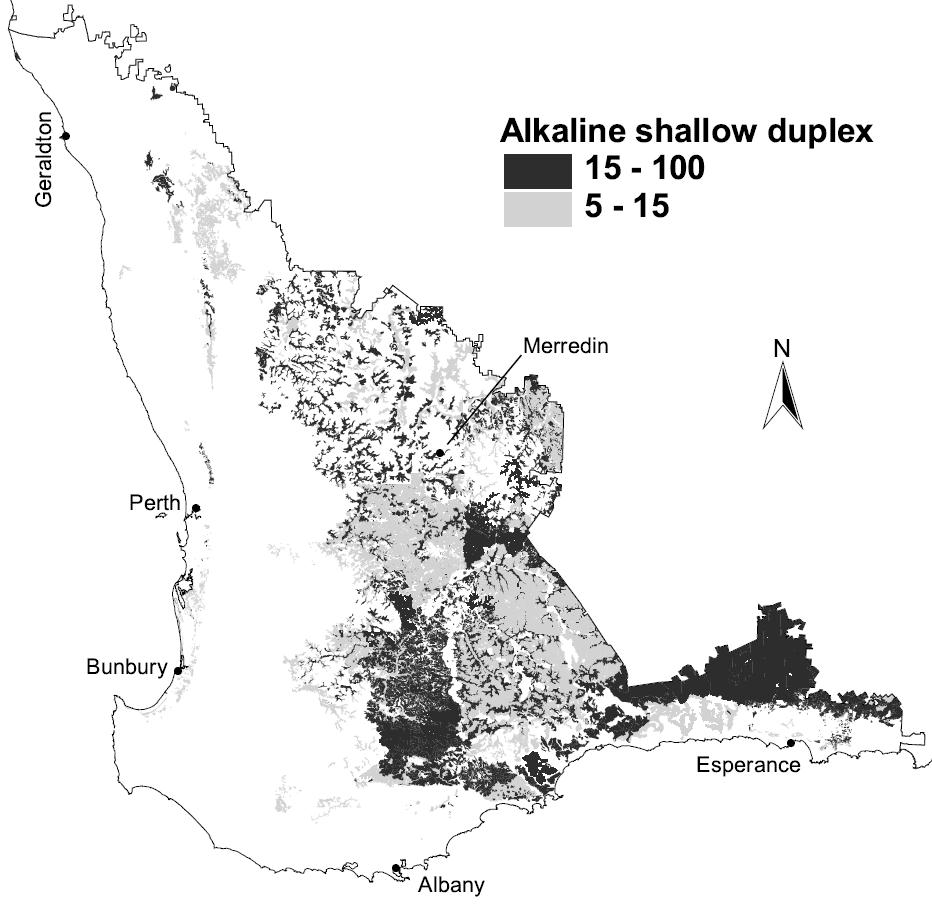Identifying properties
- Sandy or loamy surface texture
- Abrupt change to clayey subsoil at less than 30cm
- Topsoil is grey, yellow or red
- Alkaline pH subsoil
- Subsoil often calcareous
- Subsoil commonly has poor rooting conditions and slow water permeability.

Map of distribution
Key soil issues
| Issues | Description |
|---|---|
| Water storage | Often have very low soil water storage. Profiles with better structured subsoils can have up to moderate storage. |
| Fertility | These soils typically have moderate natural fertility. |
| Alkalinity | Usually moderately alkaline subsoils, with a few strongly alkaline. |
| Acidity and aluminium toxicity | Moderately acid sandy to neutral topsoils are common. |
| Salinity | Slightly soil salinity is common, with a few soils ranging to high levels of salinity. |
| Hardpan and gravel | Hardpans are rare. Small amounts of ironstone are common in the profiles. |
| Shallow soil depth | These soils are usually deep, but moderately shallow crop rooting is common on poor clays (sodic, alkaline or saline). Some structured clays can have deep rooting conditions. |
| Boron toxicity | Boron toxicity is likely in these soils especially if they are derived from marine sediments in the south-east. |
| Soil structure | Surface soils are loose (sands) or earthy (loams). Poorly structured subsurface clays can be brought to the surface during cultivation in profiles with thin topsoil. |
| Perched water tables | Perched water tables are common but vary seasonally. |
| Water repellence | The sandy surfaced topsoils are often moderately water repellent. |
| Hard setting topsoil | Hard setting surfaces are common for the loamy duplexes. Sandy duplexes are often firm. |
| Erodibility | Soils with loose sandy surfaces are highly prone to wind erosion on exposed flats and rises. Slaking topsoils and dispersive subsoils can lead to water erosion on long slopes. |
| Workability | These soils usually have good workability though sodic subsoils may cause some problems where the topsoil is thin. Many of the loamy duplex soils can not be worked when they are too wet, or are very hard when dry. |
Western Australian soil groups included in this category
| WA soil group (Ref no.) | Brief description | Common names | PAWC (millimetres per minute (mm/m)) |
|---|---|---|---|
| Alkaline grey shallow sandy duplex (402) | Grey sandy over alkaline sandy clay loam to clay at <30cm | Mallee soil, Scaddan soil, Moot soil | Very low+ to moderate |
| Alkaline grey shallow loamy duplex (502) | Grey loam over alkaline clay at <60cm | Moort soil, grey clay | Very low+ to moderately low |
| Alkaline red shallow loamy duplex (503) | Red loam over alkaline clay at <30cm | Salmon Gums soil, York gum soil, red-brown earth | Very low+ to moderate |
**Extremely low: <30mm/m
Very low: 30-50mm/m
Low: 50-70mm/m
Moderately low: 70-100mm/m
Moderate: 100-130mm/m
High: >130mm/m
+: indicates the dominant or most common values

